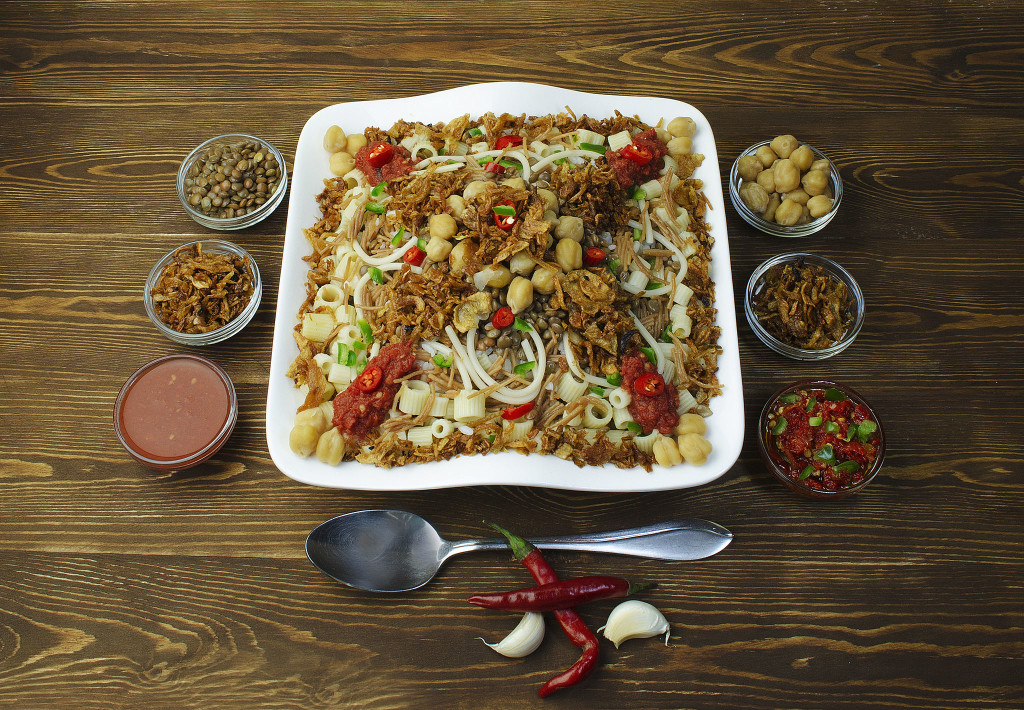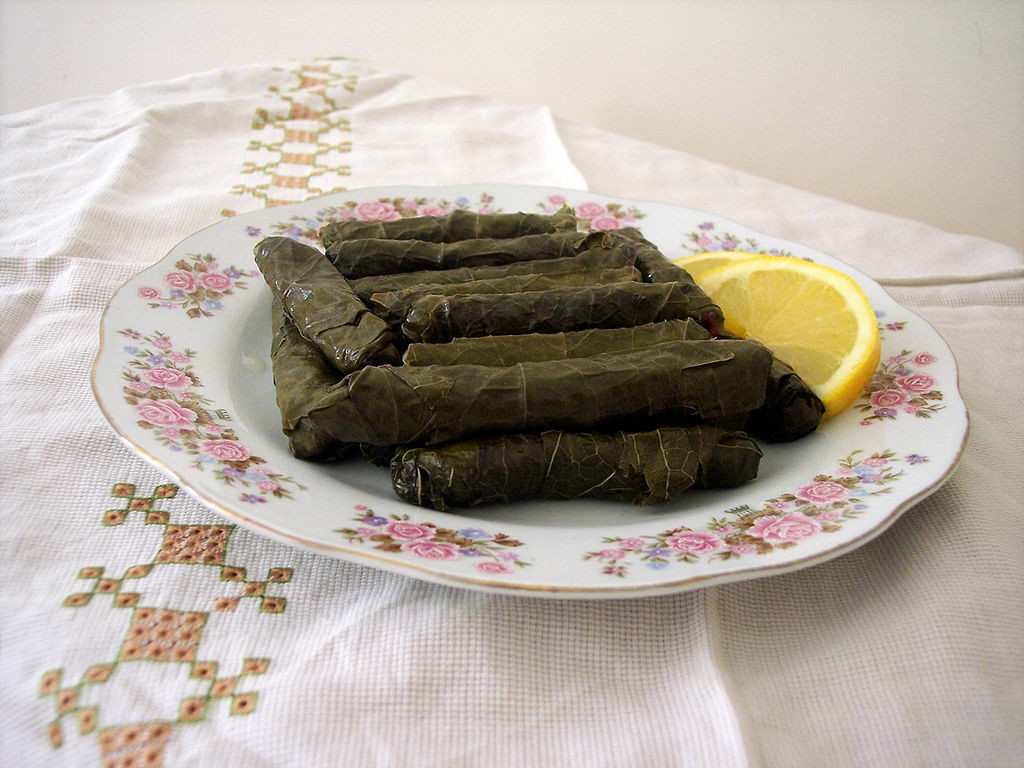This post originally appeared on Passport & Plates
Egypt is well-known for a lot of things: the Sphinx, the Pyramids, happy camels, pharaohs, hieroglyphics and the walk like an Egyptian dance. Yeah right. Egyptians don’t dance like that. Despite the fact that the average person is extremely familiar with all of the above, most people that haven’t visited Egypt don’t know much about Egyptian food. I rarely encounter Egyptian restaurants, so I’m not entirely surprised. The thing is, Egyptian cuisine can be a bit of a mystery for a traveler, so I’m here to shed some light on the situation. Behold: the 12 must eat foods when visiting Cairo – and where to find them!
1. Koshary

Koshary is a dish made of rice, macaroni, and lentils and topped with chickpeas, onion, and a special tomato-vinegar sauce. It sounds heavy and it is – it is known as a “poor man’s dish” as the ingredients are staple items that could be found in any pantry. Now koshary is a cultural phenomenon with entire shops dedicated entirely to serving this delicious yet inexpensive meal. There are lots of shops through Cairo that serve it, but my favorite is Koshary Al Tahrir. I used to hate koshary, and then I ate it in Cairo. Now it’s the first and last thing I eat every time I visit.
2. Ful Mudamas

Known as ful for short, these are simply fava beans and are a staple breakfast dish. The dish can be cooked with virtually any variety of spices; the most basic includes salt and pepper, cumin, and olive oil, but it is almost always garnished with additional ingredients. Ful is served with loaves of pita or French bread for consumption, but can also be eaten in sandwich form for those on the go. It can be found at virtually any food establishment and is actually a popular street food, but I recommend trying it at Gad. If you think hummus is great, wait until you try ful. It will have you thinking “hummus, who?”
3. Hamam Mahshi

Back in the day, I don’t think I would have ever tried hamam had I known that it was pigeon. Luckily, my palate has expanded since then and I do consider hamam a must-try dish. Despite its American reputation as a rat with wings, hamam is considered a North African delicacy. Grilled to perfection and stuffed with cracked wheat, hamam mahshi is a favorite amongst the locals. The best place to try it is Farahat.
4. Mahshi

Mahshi translates directly to “stuffed” but most commonly refers to stuffed grape leaves. This popular dish is prevalent in most Mediterranean countries, but I’m biased so I say the Egyptian version is the best. Small bites of spiced rice are wrapped tightly in grape leaves, then cooked in a tomato-based sauce and served with lemon. Mahshi is delicious – why else do you think a bunch of countries have adopted it as its own? Other popular stuffed dishes are cabbage (korumb), eggplant (bidingan), and zucchini (kossa). You can find these bites and more at Om Dahab.
5. Fiteer Baladi

Also known as Egyptian pizza, fiteer is buttery and artery-clogging goodness. It’s made of layers upon layers of filo dough and cooked in a giant brick oven. The original is served plain, but it can also be ordered sweet (with honey, syrup, and/or powdered sugar), or savory (with meat, vegetables, and/or cheese). Fatatri El Tahrir is the pick of choice here. Be warned: this is a hole in the wall place with a small seating area so don’t expect anything fancy. Despite the ambiance, the fiteer is some of the best I’ve ever had!
6. Shawarma

So you’ve been in Egypt for a few days, your stomach is finally adjusting to the food, and you’re feeling ballsy enough to try some street food. Right? Think again. Yes, shawarma has become a global street food phenomenon – meat or chicken cooked on a spit and sliced into a sandwich with veggies and sauce. That does not mean you should eat it off a random cart. Head over to Kazaz instead. Your stomach will thank you.
7. Falafel

Falafel aka tameya is another well-known staple that has found its fame abroad: the deep-fried mixture of herbs and beans is a fan favorite, especially among vegetarians. The best falafel can be found on the streets of Cairo near the same carts that serve the famous ful. But I make a point not to eat street food in countries where I’ve gotten food poisoning and opt for seemingly-safe restaurants instead. Want some traditional falafel? Felfela is your best bet. Feeling particularly trendy and worldly? Try Just Falafel. Take a look at the menu if you’re curious what I mean by “trendy falafel.”
8. Kabab and Kofta

Kofta is minced beef or lamb with spices rolled onto a skewer and barbecued over coals. Think spiced meatballs shaped like a sausage. Kabab is even better – juicy chunks of seasoned beef cooked over coals on a skewer. Order the mixed plate from Shaker and prepare for a food coma of epic proportions – if all the meat doesn’t fill you up, the sides of rice, bread, dips and veggies (see #11) surely will!
9. Molokhia

To date, I’ve never been able to appetizingly describe molokhia to someone who hasn’t tasted it, so bear with me. It’s a leafy green vegetable, but it’s never eaten raw. It’s finely chopped and cooked with a bunch of aromatic spices, and by the time it’s ready for consumption, it looks like a thick, green stew. Some people say it’s slimy, and it is ever so slightly so, but when cooked well, the taste overpowers the consistency. It’s often made with chicken or beef, but you can sometimes find it with rabbit as well (a delicacy I have not yet tried). It’s often served over rice. I’m not sure how successful I was in making it sound appetizing, but let me tell you this – all the Arab children I’ve ever encountered love it. And if it’s good enough for picky children, then it’s at least worth a try. The cooks at Abou el Sid agree.
10. Hawawshy

Hawawshy is so utterly simple that it’s hard to believe it’s a must-try dish. One can consider it a minced lamb sandwich, but it’s so much more than that. The skilled makers of hawashy roast the sandwich in a wood oven that crisps the bread so well, you would swear it was deep-fried. It’s most commonly served with pickled vegetables (#11), and can be consumed at El Hawashy el Asly.
11. Torshi

While technically not a dish on its own, torshi (pickled veggies) deserves its own mention on this list. Why? Because it is served with almost everything. In Egypt, pickles are more than just cucumbers. Almost any kind of vegetable can be turned into torshi: cauliflower, carrots, peppers.the list goes on and on. I’ll be surprised if you eat at restaurants in Egypt and don’t encounter torshi, but in case you’re feeling skeptical of all the colors in the pickle bag (did I mention it’s often served in a bag?), don’t be! It adds even more zest to the flavorful cuisine.
12. Dessert
Who would I be if I didn’t mention the famous Egyptian desserts? Desserts could honestly warrant their own post, but for the sake of efficiency, I’ll just discuss my favorite four: baklava, basboosa, knafa and Um Ali.
Baklava: crushed nuts baked between layers of filo dough and topped with a sweet syrup called sharbat.
Basboosa: a light and crumbly cake baked and topped with sharbat.
Knafa: at first glance, it looks like hay, but it’s actually really thin and fluffy filo dough – also stuffed with nuts (or cream) and topped with sharbat.
Um Ali: the direct translation of this dish is “mother of Ali.” This seems to be the popular story behind the name. In a nutshell, it’s Egyptian bread pudding made with filo dough or puff pastry, nuts, and milk. It’s lighter and milkier but just as delicious. The best Um Ali can be found at El Malky. For the other desserts and more, there’s no better bakery than the famous El-Abd.
Of course, I can go on about fabulous all the food in Egypt is. And I can probably come up with a lot more dishes to add to this list, but these are the main ones. Besides, if you’re anything like me, your stomach will need some adjustment to Egyptian food anyway, so these are plenty of options to consume between, ahem, stomach “rest days.”







Comment (1)
[…] Must Eat Foods When Visiting Cairo […]